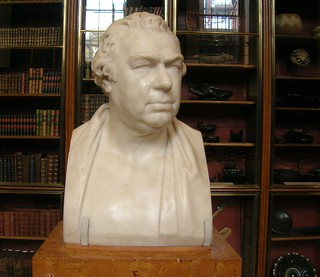Sir Joseph Banks (1743-1820) - one of the most important figures in British horticulture of the 18th Century.
Joseph Banks was born into a wealthy family of landowners in Lincolnshire; his father was also a Member of the House of Commons. Banks’ love of nature and botany started at an early age as a school boy at Eton, later he studied at Oxford University where his ambition to become the leader in all areas of natural history and in particular botany began to flourish.
In 1761 Banks’ father died, he inherited an immense fortune and became the Squire and a local magistrate. This meant he spent a lot of time travelling between London and Chelsea where his mother lived; he continued to visit the Chelsea Physic Gardens and the British museum keeping his interest in science alive. During this time he began to network with other scientists listening and expanding his understanding of science. He also began to correspond with Carl Linnaeus who devised a method of plant classification for people around the world. It was these men who in April 1766 were so impressed by Banks, nominated him as a Fellow of the Royal Horticultural Society (RHS) at the age of 23.
Also in April of 1766 Banks set sail on HMS Niger with an old friend from Eton, Constantine John Phipps now a navel lieutenant who was very interested in exploration. He jumped at the chance to join Banks and it is said it was he who negotiated passage with the naval vessel to Labrador and Newfoundland.
Banks’ critics pointed out that his Fellowship of the RHS came about due to his wealth and position within society. He could justifiably prove that he was an academically trained botanist however; it was the extent and quality of his collections from his exploration of Newfoundland and Labrador that established him as a first-rate collector.
In February of 1767 he attended the RHS first meeting and he had access to and befriended some of the most advanced horticultural minds in the country. He spent a lot of his time in stimulating conversation which continued to raise his profile and his social engagements too! It wasn’t long before he began to feel restless and in 1768 he set sail with Captain James Cook on the HMS Endeavour on a joint Royal Navy and RHS scientific expedition to the South Pacific Ocean. During this voyage he visited many countries Brazil, Tahiti, New Zealand and the East coast of Australia to name but a few. Upon his return in 1771 he accumulated a huge trove of plant and animal specimens and he and the crew returned as heroes, him especially, he was now famous in his own right. Almost 800 specimens were illustrated by Sydney Parkinson in “Banks’ Florilegium” (finally published as 35 volumes between 1980 and 1990) it was the discoveries on this voyage that will remain as one of Banks’ main legacies.
In 1772 he led an expedition to Scotland and Iceland and in 1773 he visited South Wales accompanied by an artist who produced numerous illustrations, returning from both with many botanical specimens to add to his prized and growing collections. In 1772 he bought a house at 32 Soho Square in London which was to be his home for the rest of his life. In the heart of the building was his huge scientific library said to be the finest of its kind, he also had a very large herbarium, a museum, mineral collection, insects, fish, shells, birds and animals, scientific instruments and artefacts from his travels also the many drawings and paintings. His house was always open to men of science and travellers who marvelled at his collection, on Sunday evening’s women were invited!
In 1773 he became an adviser to the Royal Botanic Gardens at Kew which flourished under his leadership; he dispatched explorers and botanists all around the world in search of economically useful species. In 1778 he was elected as President of the RHS and an informal adviser to Kind George III. In 1797 this arrangement was formalised and he was appointed to the Privy Council, Banks’ knowledge and understanding of the links between botany and the economy was to prove very important. In this year he also became the official Director of the Royal Botanic Gardens at Kew which under his care became one of the leading botanical gardens in the world.
Banks died in 1820 after supervising the first circumnavigation of Australia and becoming an inaugural member of the RHS. It is true that Banks has been and will continue to be one of the most influential botanists and scientists of his day; he did reach and exceed his ambition set as a young man whilst at Oxford University. His extensive collections which are his legacy are a valuable resource; they are still studied today and help us to understand our colonial past.
Sources:
Hobhouse, P. (2004) The Story of Gardening. Dorling Kindersley Limited.
Lyte, C. (1980) Sir Joseph Banks 18th Century Explorer. Botanist and Entrepreneur. David & Charles Inc.

